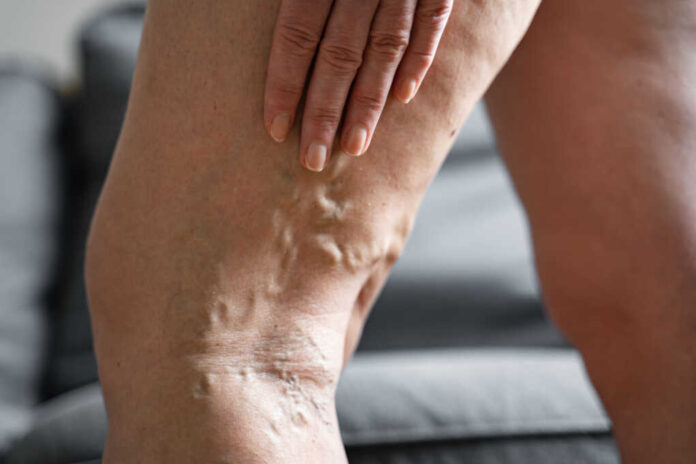
Varicose and spider veins both stem from vein valve dysfunction, but their differences can mean the distinction between a cosmetic concern and a serious health issue requiring medical attention.
At a Glance
- Spider veins are small, thin vessels visible just beneath the skin’s surface, typically considered cosmetic issues with minimal health impact
- Varicose veins are larger, twisted, rope-like veins that can cause significant discomfort and lead to serious complications including blood clots
- Both conditions share common risk factors: genetics, age, prolonged standing/sitting, and hormonal changes
- Prevention strategies include regular exercise, maintaining healthy weight, avoiding prolonged sitting or standing, and wearing compression stockings
Understanding the Difference Between Varicose and Spider Veins
When it comes to vein issues, many people use the terms “varicose veins” and “spider veins” interchangeably. However, these two conditions, while related, have distinct characteristics that affect both treatment approaches and health risks. Spider veins appear as thin, web-like patterns of blue, purple, or red lines just beneath the skin’s surface. They’re typically small—less than 1mm in diameter—and while they may cause mild discomfort in some cases, they’re generally considered a cosmetic concern rather than a serious medical issue.
Varicose veins, on the other hand, are substantially larger and more pronounced. These twisted, rope-like veins bulge visibly above the skin’s surface, primarily on the legs and feet. They’re often dark blue or purple in color and can measure several millimeters in diameter. Unlike their smaller counterparts, varicose veins frequently cause physical symptoms including pain, heaviness, itching, swelling, and fatigue in the affected area.
What Causes These Vein Conditions?
Both varicose and spider veins develop due to venous insufficiency—when the one-way valves in veins that prevent blood from flowing backward become weakened or damaged. In healthy veins, these valves ensure blood travels in only one direction: back toward the heart. When valves malfunction, blood can pool in the veins, causing them to enlarge and twist. This dysfunction is more severe in varicose veins, which is why they present with more significant symptoms and potential complications than spider veins.
Several risk factors increase the likelihood of developing either condition. Genetics play a significant role—if your parents or grandparents had vein issues, you’re more likely to develop them as well. Age is another factor, as vein valves naturally weaken over time. Women experience these conditions more frequently than men, often due to hormonal fluctuations during pregnancy and menopause. Lifestyle factors also contribute significantly: prolonged standing or sitting, obesity, lack of exercise, and smoking all increase the risk of developing vein problems.
Health Implications and Complications
While spider veins rarely lead to serious health issues, they shouldn’t be dismissed entirely. In some cases, they can cause burning, itching, or discomfort. However, they typically don’t progress to more serious vascular problems. Varicose veins, however, can lead to several concerning complications if left untreated. These include chronic venous insufficiency, where the veins cannot effectively return blood to the heart, leading to swelling and skin changes. Varicose veins can also rupture, causing significant bleeding, or develop thrombophlebitis—inflammation with blood clot formation.
Perhaps most concerning is the potential for deep vein thrombosis (DVT)—a blood clot that forms in deeper veins, typically in the legs. If a piece of this clot breaks loose, it can travel to the lungs, causing a potentially life-threatening pulmonary embolism. This serious risk makes it important to consult a healthcare provider about persistent or worsening varicose veins, especially if accompanied by pain, swelling, or skin changes.
Treatment Options and Preventive Strategies
Treatment approaches differ based on whether you’re dealing with spider or varicose veins. For spider veins, which are primarily a cosmetic concern, sclerotherapy is often the treatment of choice. This procedure involves injecting a solution directly into the affected veins, causing them to collapse and eventually fade. Laser therapy provides another option, using concentrated light to destroy the vein without damaging surrounding tissue. Most spider vein treatments require minimal recovery time and can be performed in an outpatient setting.
Varicose vein treatments tend to be more involved, reflecting the condition’s greater severity. Conservative approaches include compression stockings, which apply pressure to help veins move blood more efficiently, and lifestyle modifications like weight loss and increased physical activity. For more severe cases, minimally invasive procedures such as endovenous laser treatment (EVLT) or radiofrequency ablation may be recommended. These techniques use heat to close off problematic veins, redirecting blood flow to healthier vessels. In some cases, traditional surgery might be necessary to remove severely damaged veins.
Prevention: Keeping Your Veins Healthy
Many strategies can help prevent both spider and varicose veins or slow their progression. Regular physical activity promotes healthy circulation, while maintaining a healthy weight reduces pressure on the veins in your legs. If your job requires long periods of sitting or standing, take breaks to move around or elevate your legs when possible. Wearing compression stockings can provide support for your veins, especially during activities that put stress on your legs. Elevating your legs above heart level for short periods throughout the day can also help improve circulation and reduce swelling.
Staying hydrated and eating a diet rich in fiber and low in salt can also support vein health by promoting good circulation and preventing water retention that can increase pressure on veins. If you have a family history of vein problems or are experiencing early symptoms, consulting with a vascular specialist can help identify preventive measures tailored to your specific risk factors and ensure prompt treatment if problems arise.


















